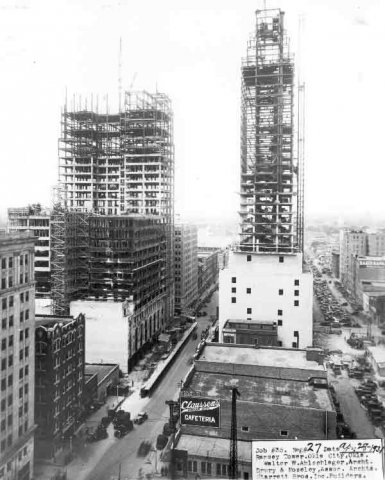Description:

Ignoring the common quip of the era, “Hey, don’t you know there’s a Depression on?”, Oklahoma City experienced a phenomenal boom in growth at the beginning of the Great Depression in the 1930s. Despite a downturn in the national economy, Oklahoma City, bolstered by oil profits, rode the crest of a four year wave of growth in tax revenues and building permits. Many pundits figured the city might be bypassed by the grim national malaise.
A symbol of this optimism was the Great Skyscraper Race of 1931 which pitted two giants of Oklahoma City’s new wealth against each other: Walter Ramsey, oil baron and First National Bank, which made millions financing oil deals. Ramsey hired architect Walter W. Ahlschlager to design his 32-story building and hired Starrett Brothers Construction to build it. Both firms were from Chicago. Ahlschlager and Starrett also teamed to build Cincinnati’s Carew Tower which is virtually a 49-story version of Ramsey Tower. The Starretts built many skyscrapers in the era including New York’s Empire State Building, then the world’s tallest, the Flatiron Building, Penn Station, and the Lincoln Memorial in Washington, DC. Frank Johnson at First National hired the Chicago firm Weary & Alford to build his 33-story tower. It was constructed by Oklahoma’s own Manhattan Construction.
First National began excavation on the property at the southeast corner of Park and Robinson in the heart of Downtown in July of 1930. Ramsey quickly secured the property directly north of the bank’s site on the northeast side of the intersection. By January of 1931, both buildings were ready to begin steelwork and then the race was on as the newspapers ran regular stories covering the race and soon office pools and even bookmakers were taking bets on which tower would go up first.
Ramsey would win the race and Ramsey Tower was offically opened on October 3, 1931. The finished building was 292,304 square feet and stood 440 feet from tip to street. The enterprise set Ramsey back about $3,000,000. His building was the tallest in Oklahoma when finished – but only for one month. First National Bank opened it’s doors in November, 1931 and could boast that although they lost the Great Skyscraper Race, they had built the tallest building in Oklahoma at 493 feet from antenna tip to street and it was over twice as large as the Ramsey in volume - 604,334 square feet. The new building featured the exclusive Beacon Club restaurant on the top floor and a 25 foot tall aircraft beacon which was fitted with a special red bulb which could be seen for 100 miles in all kinds of weather. The façade is made of molded aluminum and at the time, it was said First National contained more aluminum than any other building in the world. The final cost of the building was $5,500,000.
FURTHER READING
Lackmeyer, Steve, “Race to Build First Skyscraper Went Down to Wire,” Daily Oklahoman, December 12, 1999.
Nichols, Max and David ‘Dusty’ Martin, Continuing an Oklahoma Banking Tradition, Oklahoma City: First Interstate Bank, 1989.
“Steel Soars Skyward to Near Four Year Record”, Oklahoma, August 27, 1931, p. 5.